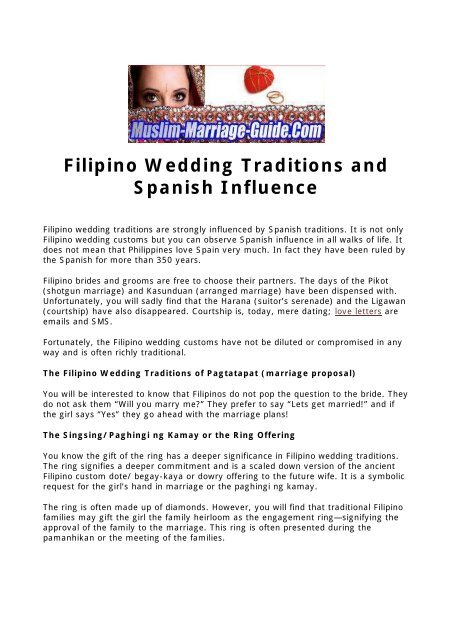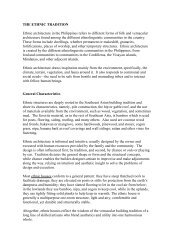Filipino Wedding Traditions and Spanish Influence - About Philippines
Filipino Wedding Traditions and Spanish Influence - About Philippines
Filipino Wedding Traditions and Spanish Influence - About Philippines
Create successful ePaper yourself
Turn your PDF publications into a flip-book with our unique Google optimized e-Paper software.
<strong>Filipino</strong> <strong>Wedding</strong> <strong>Traditions</strong> <strong>and</strong><br />
<strong>Spanish</strong> <strong>Influence</strong><br />
<strong>Filipino</strong> wedding traditions are strongly influenced by <strong>Spanish</strong> traditions. It is not only<br />
<strong>Filipino</strong> wedding customs but you can observe <strong>Spanish</strong> influence in all walks of life. It<br />
does not mean that <strong>Philippines</strong> love Spain very much. In fact they have been ruled by<br />
the <strong>Spanish</strong> for more than 350 years.<br />
<strong>Filipino</strong> brides <strong>and</strong> grooms are free to choose their partners. The days of the Pikot<br />
(shotgun marriage) <strong>and</strong> Kasunduan (arranged marriage) have been dispensed with.<br />
Unfortunately, you will sadly find that the Harana (suitor’s serenade) <strong>and</strong> the Ligawan<br />
(courtship) have also disappeared. Courtship is, today, mere dating; love letters are<br />
emails <strong>and</strong> SMS.<br />
Fortunately, the <strong>Filipino</strong> wedding customs have not be diluted or compromised in any<br />
way <strong>and</strong> is often richly traditional.<br />
The <strong>Filipino</strong> <strong>Wedding</strong> <strong>Traditions</strong> of Pagtatapat (marriage proposal)<br />
You will be interested to know that <strong>Filipino</strong>s do not pop the question to the bride. They<br />
do not ask them “Will you marry me?” They prefer to say “Lets get married!” <strong>and</strong> if<br />
the girl says “Yes” they go ahead with the marriage plans!<br />
The Singsing/Paghingi ng Kamay or the Ring Offering<br />
You know the gift of the ring has a deeper significance in <strong>Filipino</strong> wedding traditions.<br />
The ring signifies a deeper commitment <strong>and</strong> is a scaled down version of the ancient<br />
<strong>Filipino</strong> custom dote/ begay-kaya or dowry offering to the future wife. It is a symbolic<br />
request for the girl’s h<strong>and</strong> in marriage or the paghingi ng kamay.<br />
The ring is often made up of diamonds. However, you will find that traditional <strong>Filipino</strong><br />
families may gift the girl the family heirloom as the engagement ring—signifying the<br />
approval of the family to the marriage. This ring is often presented during the<br />
pamanhikan or the meeting of the families.
The Pamanhikan or Engagement<br />
The highlight of the engagement ceremony is naturally, the presentation of the ring<br />
by the groom to the bride. Thereafter, you will note that most families get down to<br />
discussing the wedding arrangements; drawing up a list of guests <strong>and</strong> the budget over<br />
a meal.<br />
Significantly, the groom’s family brings with them a home cooked specialty to share<br />
with their hosts after the engagement. Non traditional families may hold the<br />
engagement ceremony <strong>and</strong> the meal at a neutral location such as a hotel or at the<br />
home of a mutual acquaintance.<br />
The <strong>Filipino</strong> <strong>Wedding</strong> Tradition of Paninilbihan<br />
An interesting fact about <strong>Filipino</strong> wedding traditions that you will note is the practice<br />
of Panninilbihan. This tradition requires the groom to serve the family of the bride <strong>and</strong><br />
labor for their approval. In ancient days, the chores could involve chopping firewood,<br />
fetching water <strong>and</strong> so on. In the modern days, it is observed as a ritual. The groom<br />
visits the girl’s home often <strong>and</strong> he may be requested to do small tasks for the family<br />
such as driving the family members to the super market. This is seen as a method of<br />
getting to know the groom <strong>and</strong> welcoming him into the family as a valued member.<br />
Pa-alam or the <strong>Wedding</strong> Announcement<br />
Before wedding, Pa-alam or wedding announcement to the elders is considered one of<br />
the most important <strong>Filipino</strong> wedding traditions. It is a sign of respect to the elders in<br />
the bride’s family. You will find <strong>Filipino</strong> grooms visiting all the persons who matter in<br />
the bride’s family <strong>and</strong> informing them of his desire to marry the daughter of the<br />
house. The visits are very casual <strong>and</strong> the blessings of the family members are sought<br />
on such occasions. Sometimes this visit is combined with the process of distributing<br />
the wedding invitations. The bride <strong>and</strong> groom also visit their godparents/ principal<br />
sponsors with gifts such as baskets of fruit.<br />
Pa-alam or wedding announcement to elders of bride’s family is considered a must in<br />
<strong>Filipino</strong> wedding customs…<br />
However, once it is completed, you will find that the couple must visit the family priest<br />
or the parish priest as per the <strong>Filipino</strong> wedding customs. This is especially considered<br />
essential if the bride or groom is from a different parish. Interestingly, you will note<br />
that the priest is conjoined with the duty of telling the bride <strong>and</strong> the groom their<br />
duties <strong>and</strong> responsibilities as a husb<strong>and</strong> <strong>and</strong> wife <strong>and</strong> also discussing with them the<br />
possible impediments to the union.<br />
The Despedida de Soltera or the Bachelorette Party<br />
In <strong>Filipino</strong> wedding customs it is considered the bride’s final goodbye to spinsterhood.<br />
You will find that the bride’s friends <strong>and</strong> family host a send off party for the bride. The<br />
groom <strong>and</strong> his friends <strong>and</strong> family are also invited for the occasion.
The Alay-Itlog kay Sta.Clara<br />
Rain on the wedding day is considered auspicious in <strong>Filipino</strong> wedding customs.<br />
However, the bride <strong>and</strong> the groom visit the shrine of Sta Clara to offer eggs to the<br />
patron saint of good weather praying for a rain free wedding day!<br />
Kasal Kumpisal or the Cleansing ceremony<br />
Most wedding customs dem<strong>and</strong> that the bride <strong>and</strong> groom go through a cleansing<br />
ceremony before they wed. So you will not be surprised to know that the <strong>Filipino</strong> bride<br />
<strong>and</strong> groom too, are expected to cleanse themselves. The bride <strong>and</strong> groom go for final<br />
confessions a few days before the wedding <strong>and</strong> partake of the bread <strong>and</strong> wine during<br />
the nuptial mass.<br />
The <strong>Wedding</strong> Dress <strong>and</strong> the Ceremony<br />
The bride is often dressed in the White wedding gown that is popular in the west.<br />
However, some brides may wear black silk as in the <strong>Spanish</strong> tradition. The bride<br />
carries a banquet of flowers with orange blossoms <strong>and</strong> a heirloom rosary.<br />
The groom dresses in a transparent shirt called the barong over a white T shirt <strong>and</strong><br />
black slacks. The shirt is often elaborately embroidered <strong>and</strong> made of silk or jusi.<br />
The godfathers, gr<strong>and</strong>fathers, uncles <strong>and</strong> aunts of the bride <strong>and</strong> groom st<strong>and</strong> in two<br />
groups on either side of the couple. They are called ninogs <strong>and</strong> ninangs.<br />
Generally, the wedding ceremony is Catholic. You will find that the ceremony begins<br />
with the lighting of the Unity c<strong>and</strong>le. The parents of the bride <strong>and</strong> groom light one<br />
Unity c<strong>and</strong>le each <strong>and</strong> the two c<strong>and</strong>les so lighted will then be used by the bride <strong>and</strong><br />
groom to light a single c<strong>and</strong>le also called the Unity c<strong>and</strong>le to symbolize the union of<br />
the two families.<br />
Next, two members from the families of the bride <strong>and</strong> the groom will pin a veil on the<br />
shoulder of the groom <strong>and</strong> drape it over the head of the bride. Another two members<br />
will place a lasso or silk chord around the necks of the bride <strong>and</strong> the groom in the<br />
figure of eight. The groom will then give the bride arrhae or thirteen coins which have<br />
been blessed by the priest. The above ceremonies you will appreciate, signifies the<br />
everlasting bond <strong>and</strong> love between the bride <strong>and</strong> the groom <strong>and</strong> the grooms<br />
commitment to dedicate his life to the well being of his spouse <strong>and</strong> their future<br />
children.<br />
When the wedding ceremonies are complete the bride <strong>and</strong> groom participate in the<br />
reception <strong>and</strong> receive the congratulations of all their family <strong>and</strong> friends. Food <strong>and</strong><br />
drink are served <strong>and</strong> is followed by hours of dancing <strong>and</strong> merry making.<br />
Ref.: http://www.muslim-marriage-guide.com/filipino-wedding-traditions.html &<br />
http://www.muslim-marriage-guide.com/filipino-wedding-customs.html







